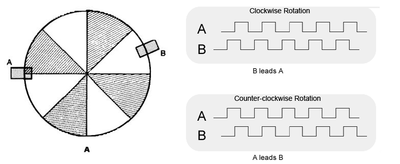Quadrature
Quadrature digital signals consists two channels (wires) and it can carry incremental setpoint or feedback signal. Quadrature signal is commonly seen in optical encoders which is probably the most common feedback device type in modern servo motors. Quadrature signal can be also used as setpoint signal and it has similar properties with pulse and direction.
Contents
Operation
Each edge of signal (from A or B channel) will increment or decrement quadrature counter value by one.
Most optical encoder specify their resolution as pulses per revolution (PPR) which will equal 4X amount of position values per revolution. I.e. 1000 PPR encoder will yield resolution of 4000 counts per revolution.
Encoder PPR, CPR, LPR and resolution
Most encoder suppliers specify quadrature encoder resolution as PPR (pulses per revolution) or LPR (lines per revolution). This specifies how many electrical pulses (0 to 1 transitions) there will be during one revolution. Some manufacturers (such as Avago and USdigital) uses name CPR (counts per revolution) to specify pulses per revolution which may seem counter-intuitive.
As each pulse will contain two edges (rising and falling) and there are two pulse channels (A and B) with 90 degree phase shift, the total amount of edges will be four times the number of PPR. Most quadrature receivers use so called 4X decoding to count all edges from encoder A and B channels yielding 4X resolution compared to raw PPR value.
Glossary
- PPR, P/R, sometimes notated as C/T
- Pulses per revolution
- LPR, L/R
- Lines per revolution (same as PPR)
- CPR
- Counts per revolution. Usually means encoder resolution after 4X decoding. However, some manufacturers (such as Avago and USdigital) specify PPR value as CPR.
An example encoder presented in different ways
| Lines or pulses per revolution / LPR or PPR | 2000 |
| Counts per revolution / CPR | 8000 |
| Actual position control resolution | 8000 steps per revolution |
| Mechanical servo accuracy including tracking error | Theoretically 1/8000. In typical case this would yield 1/500 to 1/2000 mechanical accuracy in dynamic conditions (not standing still). |
In no event the Product Information or parts hereof shall be regarded as guarantee of conditions or characteristics. The Product Information or any part thereof may also not be regarded as a warranty of any kind. No liability of any kind shall be assumed by Author with respect to Product Information or any use made by you thereof, nor shall Author indemnify you against or be liable for any third party claims with respect to such information or any use thereof.
As content of this Wiki may be edited by user community, Granite Devices Oy or it's affiliates do not take any responsibility of the contents of this Wiki. Use information at your own risk. However, Granite Devices staff attempts to review all changes made to this Wiki and keep information trustworthy.
Without written consent, Granite Devices' Products or Intellectual Property shall not be used in situations or installations where living beings, material property, or immaterial property could be harmed by the operation, features or failures of Product. Products may only be used in a way where hazards like moving parts, electric shock, laser radiation, or fire can't be realized even if the content of this Wiki would suggest otherwise.

